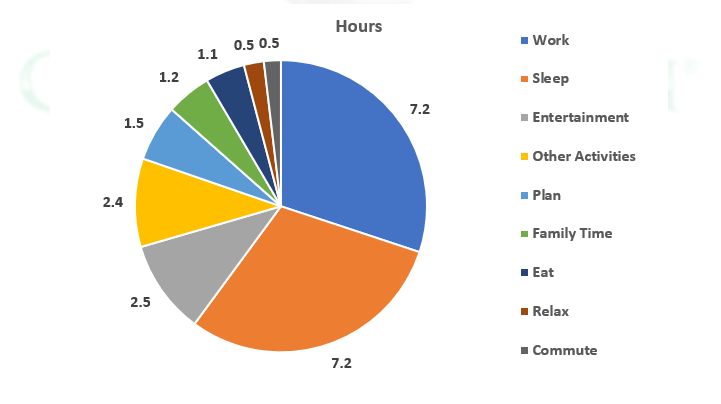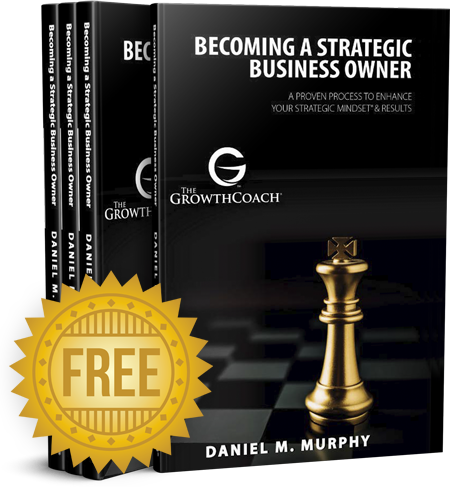Time is the one thing we can never get back. For centuries, physicists and mathematicians have attempted to find a way to travel back in time. Some of Hollywood’s blockbuster films have centered around the concept of time travel. Films like The Terminator, Bill and Ted’s Excellent Adventure, Time Cop, Hot Tub Time Machine, The Time Traveler’s Wife and all three Back to the Future movies all provide different perspectives for the same problem – how do we change what is happening now by altering the past. In other words, how can we plan and manage our time more effectively?
Proper time management is far more than managing your calendar and appointments or checking items off a task list. The art of time management is knowing which items to work on and in what order to reach your goals and objectives. As with any mindset change, practice, planning and accountability are keys to success. Without these three elements, you can quickly become frustrated and will continue to ‘not have enough time’!
Easier Said Than Done
Although days are getting longer by 1.7 milliseconds every century (Scientific American, Fact or Fiction: The Days (and Nights) are getting longer), we essentially have 86,400 seconds every day to get things done. No matter how hard we try, we must carve up our time against a 24-hour window. However, with so many competing elements ranging from family, business, health, safety and security, and many others unique to each of us, striking the right balance is essential. In the end, if you’re constantly missing deadlines, frustrated objectives are not being reached and tired of being busy without getting anything done – its time to make a change.
To begin, we need to know where we spend our time. Jot down the main categories you spend time on and then mark how much time you spent that day on those items. The point to the exercise is not necessarily precision, but rather direction. We’re just trying to get perspective on where time is being spent and on which activities. Below are the results from my tracking:
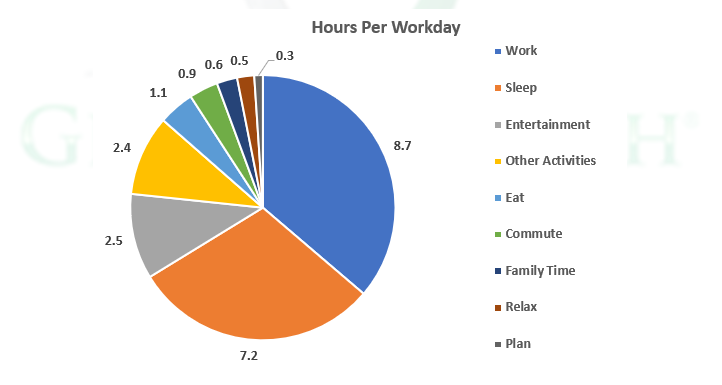
My reason for doing this was simple – I felt I was busy being busy, but not really accomplishing anything. I was very surprised to see that I was spending as much time eating as I was relaxing and spending time with my family, combined. I knew something had to change, but I wasn’t sure where to start.
Urgent Versus Important
At the end of the day, time management is a function of tasks to do and time available. We all have items that must be completed right away and those that can be pushed out. Additionally, there are tasks we must work on because they drive personal or organizational goals. These two distinct layers can drive a prioritization matrix. The hard part – if everything in your day is urgent and important, you’ll never accomplish your goals. Conversely, if you focus on important tasks, but none are very urgent, you may be neglecting things that could become serious issues. The key is striking a balance across these items.
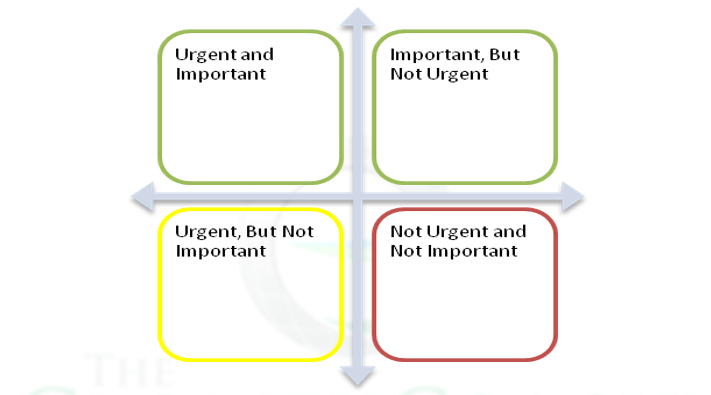
Urgent & Important
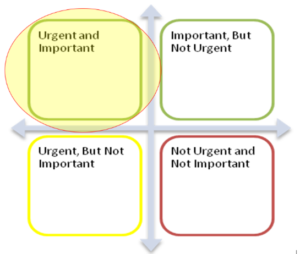 As the label implies, urgent tasks need to be completed very soon with varying levels of severity if they are not finished. For example, if you have not done payroll from last Friday, that would be extremely urgent for you and highly important for your employees. Additionally, an ice rink refrigeration pump that has failed needs to be solved quickly or the facility will lose revenue from missed ice time. Items in this upper-left corner of the matrix are often described as the mission-critical tasks that must be completed immediately. Procrastinating on these items may have detrimental results including legal, personal and safety outcomes. Typically, these are tasks that cannot be delegated away, but must be completed as quickly as possible.
As the label implies, urgent tasks need to be completed very soon with varying levels of severity if they are not finished. For example, if you have not done payroll from last Friday, that would be extremely urgent for you and highly important for your employees. Additionally, an ice rink refrigeration pump that has failed needs to be solved quickly or the facility will lose revenue from missed ice time. Items in this upper-left corner of the matrix are often described as the mission-critical tasks that must be completed immediately. Procrastinating on these items may have detrimental results including legal, personal and safety outcomes. Typically, these are tasks that cannot be delegated away, but must be completed as quickly as possible.
Urgent and Important items can also be described as “fire drills”. These happen as part of daily life. For example, if your spouse or partner locks their keys in their car, for their safety (and sanity), bringing the spare set of keys to them is highly urgent and important. The message here is that not all events can be planned for. However, if all your tasks are falling in this bucket, chances are you’ve done some procrastinating along the way or didn’t prioritize your time accordingly. But that’s okay! The key to the model is flexibility.
Important But Not Urgent
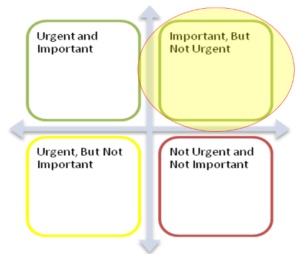 Of the four boxes in the grid, business owners MUST learn to live in this box. Planning, strategy, opportunity identification and goals stem from determining which tasks are important to drive the organization. Additionally, by thinking through these non-urgent tasks, the probability of success will increase significantly because you had time to plan.
Of the four boxes in the grid, business owners MUST learn to live in this box. Planning, strategy, opportunity identification and goals stem from determining which tasks are important to drive the organization. Additionally, by thinking through these non-urgent tasks, the probability of success will increase significantly because you had time to plan.
For example, you want to grow your revenue by 40% by 2022, but your current facility is at 90% occupancy for ice time. Sounds like you need a new rink! This highly important goal has countless tasks under it, but do not have to be immediately solved for. This allows you to develop a market strategy, identify a location, hire and train the right people and evaluate success. If you have one box to focus your time on – as a facility manager, employee or owner – managing important, but not urgent tasks will help deliver against organization goals and objectives. Why? Because you have time to think and not just react.
Sounds easy to do but aligning tasks to this grouping can be extremely challenging. One of the best places to start is evaluating operational and financial goals. Then determine which activities support those goals. If you are working on something that doesn’t support a long-term goal, the task is most likely not in the right quadrant. This certainly doesn’t mean the task isn’t worth doing, but just be aware of the amount of time spent on items that don’t deliver against the correct goals.
Urgent But Not Important
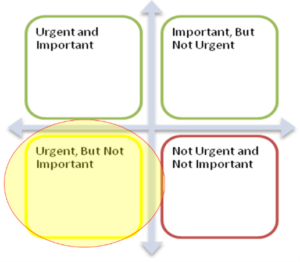 The best way to describe these tasks are ‘normal, day-to-day’ items. You will have to check voicemail, email, hold meetings with staff and customers and so on. These are the tasks that keep the facility running and pay the bills. However, many of these items can be delegated. Many owners may find these tasks offer career development opportunities for employees as well. For instance, you know the fall league schedule has some open slots on Friday evenings and Saturday mornings. You decide to send a mailer out to local teams, coaches and leagues who may be looking to expand as well. At that point, you have an urgent item that may not be highly important now.
The best way to describe these tasks are ‘normal, day-to-day’ items. You will have to check voicemail, email, hold meetings with staff and customers and so on. These are the tasks that keep the facility running and pay the bills. However, many of these items can be delegated. Many owners may find these tasks offer career development opportunities for employees as well. For instance, you know the fall league schedule has some open slots on Friday evenings and Saturday mornings. You decide to send a mailer out to local teams, coaches and leagues who may be looking to expand as well. At that point, you have an urgent item that may not be highly important now.
This would be a great opportunity to see if the graphic design student on your staff would be interested building a campaign and executing against it. It would allow your employee to show what they can do and give them experience. Even better – if frees up your calendar to focus on the Important, But Not Urgent items that drive the organization forward.
Not Urgent & Not Important
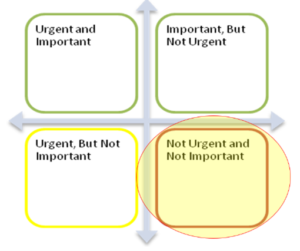 These can mask themselves as other priorities, but it is key to identify them. If you get a call from a high school friend wanting to have lunch one afternoon to catch up, although a fun time, its most likely not urgent or important. That last sentence usually perks a few folks to question the logic – ‘are you saying my friend isn’t important’? Well, sort of. The reasoning is that a lunch with a friend to catch up can be rescheduled easily without material consequences. Sure, you may have to pick up the check as a penance, but hey – they are your friend and you’re happy to see them!
These can mask themselves as other priorities, but it is key to identify them. If you get a call from a high school friend wanting to have lunch one afternoon to catch up, although a fun time, its most likely not urgent or important. That last sentence usually perks a few folks to question the logic – ‘are you saying my friend isn’t important’? Well, sort of. The reasoning is that a lunch with a friend to catch up can be rescheduled easily without material consequences. Sure, you may have to pick up the check as a penance, but hey – they are your friend and you’re happy to see them!
Another way to think of these items are whether the rink would go under in any way if don’t do the task. Keep in mind, these are activities that take you away from focusing and completing items in the other three grid boxes. I will also add, if your high school friend wants to catch up and partner with you to build a new rink, you may want to move that lunch date up into the Important and Not Urgent box since it aligns tightly with growing your business.
Aligning Priorities to Available Time
If you recall from the opening paragraphs, I was spending my time in places that did not drive value for me personally or professionally. Sure, I was always busy, but the mix of activities was not sustainable, which lead to frustration. With practice and continual evaluation, shifting focus from Urgent and Important to Important but Not Urgent opened schedule opportunities.
The largest shift must be planning. If you begin to shift your mindset away from Urgent and Important, you start thinking like a strategic leader. If you are constantly reacting, you cannot be driving your business. In fact, without planning and focusing on the right tasks, your facility is running you – you’re not running your facility.
Finally, this mindset is far more than creating a list and checking boxes. Those items may exist on both Urgent panes, but it will take significant practice to strategically look at tasks and determine where they belong. You cannot get to everything and that’s okay. They key is to spend as much of your time on the Important and Not Urgent items as you can. Those items deliver value and move you closer to reaching your facility’s goals.
A fun exercise is to see during your next team meeting how many of your team have matching tasks and where they feel they fall on the grid. Organization alignment will reduce turnover, improve customer retention rates, increase margins and deliver fewer stress filled days. If everyone knows how their tasks align, everyone will be on the same page and ready adjust to crisis as they happen. This mindset can be difficult to change, but you CAN do this! With patience, practice and a coach to challenge and hold you accountable, you can master time management that delivers personal and professional success!
